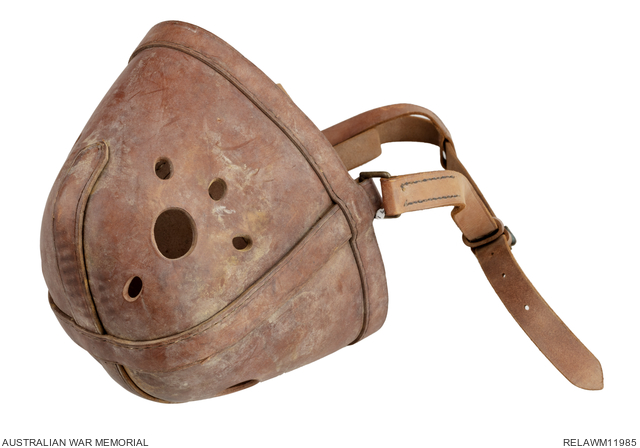| Place | Oceania: Australia |
|---|---|
| Accession Number | RELAWM11985 |
| Collection type | Heraldry |
| Object type | Heraldry |
| Physical description | Leather, Metal |
| Maker |
Unknown |
| Place made | Australia |
| Date made | 1930s |
| Conflict |
Period 1930-1939 |
| Source credit to | This item has been digitised with funding provided by Commonwealth Government. |
Horse sand muzzle: Australian army mounted and transport units




Sand muzzle with curved base constructed from three triangular panels of 4 mm brown blocked leather. The panels are held together with stitched bands of 25 mm wide leather. A further band is sewn around the open top of the muzzle. Opposing loops in the band running across the sides of the muzzle to the upper edge carry a square brass ring. Attached to these are the short and long ends of the head strap, which incorporates a 20 mm wide slip head browband. The short end of the strap, which has two leather keepers, measures 250 mm and finishes with a brass buckle. The long end of the strap measures 1040 mm and carries nine size adjustment holes. Each rear panel of the muzzle has a 30 mm diameter ventilation hole placed 75 mm above the intersecting leather bands at the bottom. There are similar holes in the front panels together with a small oval hole 20 mm beneath them and a pattern of three small holes of the same dimension 20 mm from the upper edge of the large hole.
The left rear panel is stamped with an acceptance mark 'A.A.O.D [broad arrow symbol] V.' (Australian Army Ordnance Department - Victoria).
Australian made sand muzzle acquired by the Australian War Memorial c 1936-1938. It was part of a complete set of saddlery issued by the Australian Army Ordnance Department in Victoria for display on the figure of the Australian waler then being prepared by taxidermists in London, which was in place when the Australian War Memorial opened in Canberra in 1941. The sand muzzle was never displayed with the rest of the saddlery on the horse. It is not the pattern that was used in the First World War (see RELAWM04233 and photo B00460).
Sand muzzles were designed to combat sand colic, a condition caused by the ingestion of sand or soil which settled in a horse's gut and caused either a major digestive upset which was not easily relieved, or a twisted bowel due to the horse rolling violently to relieve discomfort and pain. The latter condition was invariably fatal at the time.
They were worn in the lines, or while resting in the field, by horses who had a tendency to seek additional scraps of forage on sandy or bare ground, especially when feed was in short supply. Horses known to do this were issued with sand muzzles that allowed them to breath, but restricted their ability to forage. On the march or in action the muzzle was carried at the base of the horse's neck, secured by the head strap.